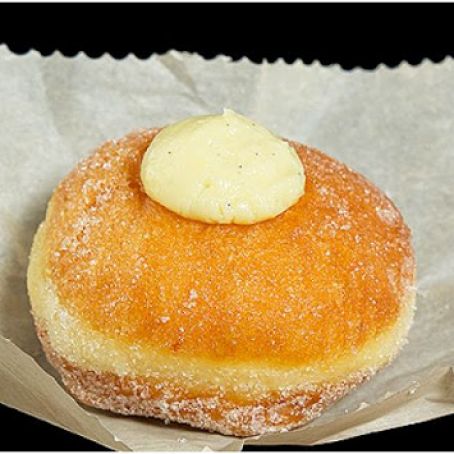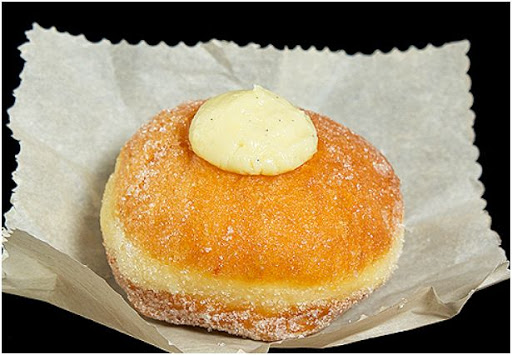Bomboloni alla Crema – Italian Cream-Filled Donuts
By ctozzi
Bomboloni, fluffy pillows of rich and tender fried pastry dough rolled in sugar and filled with velvety Crema Pasticcera {Italian Pastry Cream}, fresh and warm out of the oven.
 1 Picture
1 Picture
Ingredients
- Crema Pasticcera {Italian Pastry Cream}:
- 250 g (2 cups) bread flour
- 250 g (2 cups) Italian “00″ (doppio zero) flour or plain (all-purpose) flour
- 50 g (about 1/4-cup) caster (superfine granules) sugar
- 8 g (1 package) instant yeast or 25 g fresh yeast
- Seeds from 1 vanilla bean
- Zest of 1 orange or zest of 1 lemon (I prefer orange-you could also use a combination of orange and lemon)
- Pinch of salt
- 250 ml (about 8 1/2 ounces) warm milk, temperature between 40°C and 43°C (105° F and 110° F)
- 3 large eggs
- 50 g (3 1/2-tablespoons) unsalted butter, cut into 4 pieces, softened
- Vegetable spray
- Vegetable or canola oil, for frying
- Caster (superfine granules) sugar, extra, for rolling
- 500 ml (2cups) whole milk
- 1 vanilla bean, split and seeded
- 6 large egg yolks
- 180 g (3/4 cup + 2 1/2 teaspoons) caster (superfine granules) sugar
- 40 g (1/3 cup or 5 tablespoons) plain (all-purpose) flour, sifted
Details
Preparation
Step 1
1.Place flours, sugar, instant yeast, vanilla bean seeds, zest of your choice and salt in a large bowl. Using a large whisk, whisk to well combine.
2.Make a well in the centre; pour in the warm milk. Work together the milk and the dry ingredients with the tips of your fingers.
3.Add the eggs all at once; work together the ingredients until you have a rough ball of dough.
4.Gradually add the butter, one-piece-at-a-time, working each piece of butter into the dough before adding the next.
5.Transfer dough to a clean, lightly floured work surface; knead until smooth and elastic (not sticky), 10 to 15 minutes.
6.Transfer dough back to the large bowl; cover with a sheet of plastic wrap and leave to rise in a warm place, 1½ to 2 hours.
7.When the dough has doubled in volume, transfer to a clean, floured work surface.
8.Roll the dough out to a thickness of about 1 cm (a little less than ½-inch); using a cookie cutter or glass cut out rounds about 7-cm to 7½-cm (2¾-inch to 3-inch) in diameter (keep the cuts as close together as possible). (Gather up the leftover pieces, give a quick knead to bring the pieces together, return dough to the bowl, cover and leave to rise in a warm place until double in volume, about ½-hour and proceed to roll out and cut out rounds. At this point if you have any remaining dough, gather together re-roll and cut rounds until all of the dough has been used.)
9.Place the rounds on a parchment lined baking sheet lightly sprayed with vegetable spray, cover with a sheet of plastic wrap and leave to rise in a warm place until doubled in volume (they should appear full of air), 1½ to 2 hours. (I find it much easier to remove the rounds from the parchment paper when I lightly coat the parchment with vegetable spray opposed to flouring the parchment sheet. I also used a 3-inch deep baking pan instead of a baking sheet to place my rounds in to rise, this ensures the tops of my bomboloni will not stick to the plastic wrap.)
10.Heat oil in a 6-litre/quart heavy-bottomed saucepan over medium heat to between 160° C and 170° C (320° F and 340° F), about 20 minutes. (Check your oil frequently while frying bomboloni to maintain these temperatures. If you have a thermometer attach to the saucepan to monitor the temperature of the oil.)
11.Prepare 2 large plates for draining and rolling of bomboloni. Layer one plate with 3 to 4 sheets of paper towel for draining, and the other plate with a thin layer of caster sugar, for rolling, set-aside until ready to use.
12.Fry four to six bombolone at-a-time to ensure even frying. Fry until golden on both sides, 3 to 5 minutes. (Bomboloni should be golden on both sides creating a distinct line lighter in colour in between – can be difficult at times to achieve because the bomboloni have a mind of their own and they puff up while cooking, sometimes more on one side than the other.) Remove bombolone, one-at-a-time, with a spider skimmer or slotted spoon, drain on paper towels and immediately roll in caster sugar until evenly coated.
13.While bomboloni are still warm fill with Crema Pasticcera (Italian pastry cream). To fill bomboloni, transfer Crema Pasticcera to a large pastry bag fitted with a ½-cm to 1-cm (¼-inch to ½-inch) plain round tip. Use a sharp paring knife to make a small hole (in the centre) on the top of each bombolone. Insert pastry tip into the hole of the bombolone and pipe crema until the bombolone feels heavy; continue to fill until you have a mound of pastry cream visual on the top of the bombolone.
14.Bomboloni are best enjoyed on the day they are made. Serve immediately.
Crema Pasticcera {Italian Pastry Cream}:
1.In a small saucepan bring milk, vanilla bean, and vanilla bean seeds just to the boil over medium heat. Remove from heat, cover and let steep 10 to 12 minutes.
2.In a large bowl, using a large hand whisk, cream together egg yolks and sugar until thick and pale.
3.Add the flour and whisk to well combine.
4.Gradually, in a steady stream, add the hot milk mixture to the egg mixture; whisking constantly until well combined.
5.Return the milk-egg mixture to the saucepan and cook over medium heat, whisking constantly, until thickened, about 3 to 5 minutes.
6.Remove from heat and strain Crema Pasticcera through a fine mesh sieve into a 20-cm (8 inch) square dish or 23 X 33 cm (9 X13 inch) rectangular dish. Discard solids. (A little tip for you – I remove the vanilla bean; give it a quick rinse and then allow it to dry and use it when I am making syrups or compotes (gives the compote or syrup a hint of vanilla taste) or I also place the vanilla bean in a mason jar (a large one because I continue to add beans and top with more sugar as I go along) with sugar and make my own vanilla sugar (make sure the vanilla bean is completely dry before storing with sugar.) (This time I saved the vanilla bean and used it to make my stems for decorating the completed Pesche.) Place a sheet of plastic wrap directly onto Crema Pasticcera to prevent a skin from forming while cooling. When Crema Pasticcera has completely cooled place in refrigerator to chill until ready to fill cookies.

Review this recipe